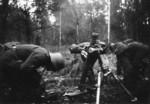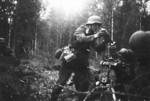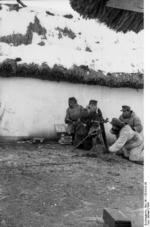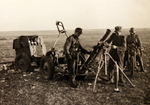8 cm Granatwerfer 34 Launcher
| Country of Origin | Germany |
| Type | Launcher |
| Caliber | 81.400 mm |
| Barrel Length | 1.143 m |
| Weight | 62.000 kg |
| Ammunition Weight | 3.50 kg |
| Rate of Fire | 15 rounds/min |
| Range | 2.400 km |
| Muzzle Velocity | 174 m/s |
Contributor: Alan Chanter
ww2dbaseIn modern warfare the mortar is an invaluable weapon for use against hostile machine-gun emplacements, snipers' posts or other enemy constructions in the front line that cannot effectively be destroyed by rifle fire. Their high trajectory makes them particularly useful in mountainous (where pieces of this calibre could conveniently be broken down into loads suitable for transportation by one pack animal) or wooded terrain where the problem of crest clearance could often not be surmounted by light artillery over short ranges. The mortar's main drawback, however, is that as they need to be well forward to be of service, ammunition resupply can create some difficulty.The 8cm Granatwerfer (GrW) 34 (heavy grenade-launcher model 1934) was the standard German medium mortar in World War II. Built in large numbers between 1934 and 1945 its manufacturer, Rheinmetall-Borsig, produced a high-quality weapon that, following standard mortar design, earned a reputation for being extremely reliable, accurate and having a decent rate of fire. It could throw a 3.5kg bomb, which was not all that much lighter than the 5.45kg shell of the 75mm Infantry gun, out to some 2,400 metres and with a well drilled crew, experts at their craft, could put twenty-five 3.5kg bombs on to the target in a minute (87kg) as opposed to the infantry gun which could put down only twelve 5.4kg of HE (65.4kg) over the same time period. The well trained amd enterprising German mortar crews always seemed to possess an ability to engage in and out of action rapidly and, with careful attention paid to pre-registration and other fire control aids, became renowned for their ability to bring fire down rapidly on any adversary.
Despite having only two-thirds of the range of the 75mm Infantry Gun the GwR 34 mortar was very much lighter and, owing to its smooth bore and less complicated recoil system, could be more speedily and cheaply manufactured. In addition the GwR 34 could be broken into three loads (barrel, bipod, baseplate) which made them well suited for transport by air, thus making them especially useful to airborne divisions. These advantages were what convinced many European countries, Great Britain among them, that the infantry gun had had its day. Nevertheless, the infantry gun, especially with shaped charge projectiles, did have an anti-tank capacity (which the mortar was not to develop until recently). In the German army, handicapped as it would become in World War II by an insufficient artillery establishment, mortars, particularly on the northern sectors of the Russian front, tended more and more to replace the infantry gun as the preferred close support weapon. Indeed, as a result of combat experience by both sides in this theatre heavier models were eventually developed, of which the Finnish 120mm Tampela mortar was one of the best. This and similar large calibre mortars, some up to 150 mm calibre, had a round instead of a square base plate, detachable wheels, and would normally be towed about the battlefield in much the same way as a field-gun, but with the muzzle foremost. One of the unique innovations developed by the Germans for their 81mm mortar was the "bouncing bomb". The concept was to burst a bomb in the air so that shrapnel would rain down on enemy troops behind cover. Although air burst could be achieved by fitting the bomb with a simple time fuse, this introduced unwelcome complications in determining the setting, setting it, and so on. The bouncing bomb, therefore, employed an impact fuse and merely had to be dropped down the barrel and fired. On impact, the fuse fired a small charge of smokeless powder in the head of the bomb, which blew it back up into the air, igniting a short delay-fuse as it ascended. When the bomb had "bounced" about 30ft in the air, the delay fuse burned through and detonated the bomb's high explosive filling to give an air burst with highly lethal effects on those below.
Self-propelled Mortars were a relatively uncommon sight in World War II. The Americans armed some modified M2 amd M3 Halftracks with 81mm mortars for employment with armoured infantry regiments and these would mainly see action in the North West Europe campaign. The German army used two types - the SdKdz 251/2 and the SdKfz 250/7 Granatwerfwerwagen, both armed with the GrW34 mortar. The former was typically used to equip a six weapon mortar troop in the heavy weapon companies of armoured panzergrenadier and armoured reconnaissance battalions. The SdKfz 250/7 mounted in the versatile little SdKfz 250 halftrack; (in troops of three vehicles - one 250/1 for the troop commander and two 250/7 SP Mortars) were generally employed to provide fire support within the 2nd and 3rd car companies (Auflärungs- Kompanie) in the armoured reconnaissance battalions (of German Panzer Divisions).
Sources:
Jim Webster, Hitting Them with the Heavy Metal, Germany 1939-45 (Wargames Illustrated)
Ian Hogg, Mortars (War Monthly Issue 3)
Ian Shaw, Weapons amd Equipment of WWII (Tabletop Games)
Bryan Perrett, German Armoured Cars and Reconnaissance Half-Tracks 1939-45 (Osprey New Vanguard, 1999)
Everyman's Encyclopedia
ww2dbase
Last Major Revision: Aug 2013
Photographs
 |  |  |  |
Please consider supporting us on Patreon. Even $1 per month will go a long way! Thank you. Please help us spread the word: Stay updated with WW2DB: |
Visitor Submitted Comments
2. Ravi says:
16 Aug 2022 02:00:18 PM
Hi. Nice brief entry. But adding crew numbers and daily unit of mortar rounds (rounds for one day) would helpsomone of us!
16 Aug 2022 02:00:18 PM
Hi. Nice brief entry. But adding crew numbers and daily unit of mortar rounds (rounds for one day) would helpsomone of us!
All visitor submitted comments are opinions of those making the submissions and do not reflect views of WW2DB.
Search WW2DB

News
- » Wreck of Teruzuki Found (27 Jul 2025)
- » USS Orlean's Bow Found (22 Jul 2025)
- » The Emperor of Japan Planned to Honor WW2-era Japanese POWs in Mongolia (4 Jul 2025)
- » US State Lawmaker John Winter Caught Using Racial Slur "Jap" and Apologized (11 Jun 2025)
- » US Government Plans to Purge WW2 Information (17 Mar 2025)
- » See all news
Current Site Statistics
- » 1,182 biographies
- » 337 events
- » 45,119 timeline entries
- » 1,248 ships
- » 350 aircraft models
- » 207 vehicle models
- » 376 weapon models
- » 123 historical documents
- » 261 facilities
- » 470 book reviews
- » 28,409 photos
- » 365 maps
Famous WW2 Quote
"No bastard ever won a war by dying for his country. You win the war by making the other poor dumb bastard die for his country!"George Patton, 31 May 1944
Support Us
Please consider supporting us on Patreon. Even $1 a month will go a long way. Thank you!
Or, please support us by purchasing some WW2DB merchandise at TeeSpring, Thank you!
8 Nov 2017 09:02:12 AM
Excellent .Am researching for a soon to be published book on the German Infantryman.